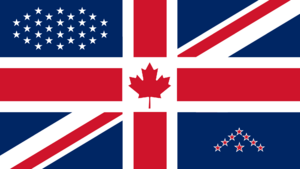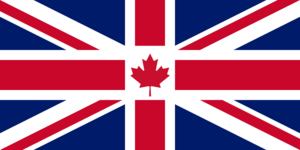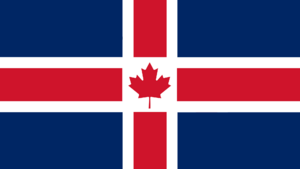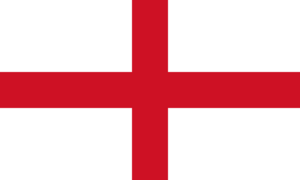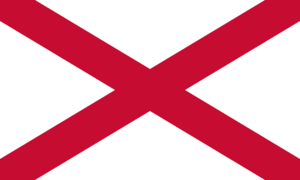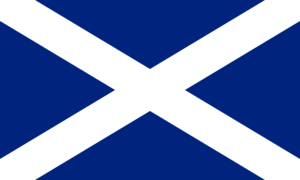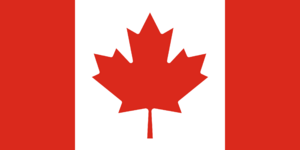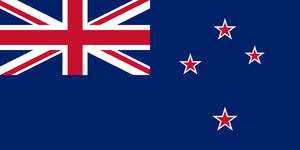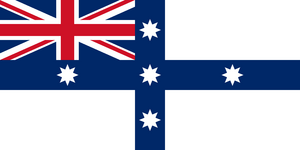Orleóis
Imperial Britannic Commonwealth Britannia | |
|---|---|
Coat of arms
| |
| Motto: Long Live Britannia! | |
| Anthem: Long Live Britannia | |
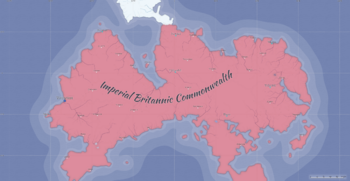 | |
| Capital | Valtoria |
| Largest city | Lithandril |
| Official languages | Breton |
| Recognised national languages | English |
| Demonym(s) | Breton/Britannic |
| Government | Federal presidential crowned republic |
• Her Royal Majesty | Queen Eleanor IV |
• Prime Minister | Valerius Eäron |
• Federal Chancellor | Manfred Leitzke |
| Legislature | Imperial Parliament |
| House of the Realm | |
| Commonwealth Council | |
| Establishment | |
• End of the Peninsular War | January 17, 1672 C.E. |
• Unification Day | April 14, 1681 C.E. |
• Current constitution | April 14, 1913 C.E. |
| Area | |
• Total | 853,009 km2 (329,349 sq mi) |
| Population | |
• 2020 census | 110.336.793 |
• Density | 129.35/km2 (335.0/sq mi) |
| GDP (nominal) | 2019 estimate |
• Total | US$6.2 trillion |
• Per capita | US$56.218,21 |
| HDI (2019) | 0.946 very high |
| Currency | imperial pound ruby |
| Date format | dd.mm.age:year |
| Driving side | left |
| Calling code | +7 |
| Internet TLD | .co.br |
The Imperial Britannic Commonwealth, also alternatively referred to as the Commonwealth, the Britannic Realm/Empire or simply Britannia, is a federal presidential crowned republic composed of seven semi-autonomous territorial divisions named Popular Republics, as well as one federal district (the capital city of Valtoria). The Commonwealth is a sizable nation at just over eight hundred thousand square kilometers and with a population numbering roughly 110 million. The country occupies a peninsula and is surrounded to the south by the Bay of Isa and, farther south, the Ocean of Sorrow. To the east is the Ocean of Reneria; in the north, the Bay of Elvira and the Ocean of Deris; to the west, the Ocean of Cylësen. In the center of the peninsula there is a large gulf, known as the Sea of Auriel.
The Commonwealth’s different members were largely known for their isolation to the outside world, preferring to interact amongst themselves — including through war — than interact with the rest of civilisation in anything other than trade. This was set for future change, however, after Duvaineth’s ascension to the throne of the Aterni Empire following its conquests in what is now known as the Peninsular War. Though the United Britannic Kingdoms did little to cement that change, it laid the groundwork for the establishment of the Imperial Britannic Commonwealth, which would significantly change its foreign policy, especially in support of socialist revolutions around the globe.
Today, the Commonwealth is a member of the international community and is well-known for its preference of non-violence and diplomacy to settle disputes. Its once large colonial empire, established during the end of the United Britannic Kingdoms and greatly expanded upon during the first half of the 20th Century under the rule of King Messner III and Queen Valeria V has since been fully decolonised, becoming a loose alliance of territories (over which the Royal Prerogative is recognised as Head of State, but with no political relation whatsoever) known today as the Imperial Union.
Etymology
It is unclear where the term “Britannia” first emerges, although it has been found that it appears several hundred years prior to the creation of the first entity to occupy the entirety of the territory known as Britannia today. The first registered appearance of the name is from -21:25, in an epic written by famous classical novelist and poet Fidena. However, historical accounts of her works and their popularity within Britannic societies at the time indicate that it was unlikely she was the first to coin the name, rather implying she utilised a common phrase to refer to those inhabiting those territories.
Some scholarly studies have (inconclusively) concluded that the term Britannia originates from Volsini, today one of the seven Popular Republics of the Commonwealth. It is believed that Volsini named the continent this way after its leader, Eothomas, who first led Volsini armies onto the mainland and began conquering what would eventually become the First Volsini Empire. This is uncertain, as it is believed that certain texts found prior to the ascension of Eothomas to the Volsini crown already mention this continent, despite their authenticity having been brought into question multiple times.
History
The recorded history of the dozens of kingdoms and empires that spanned the Britannic territory is rich most notably in war and violence. Tales of glorious conquests of national foes are explicitly depicted in elaborate monuments erected in a variety of different locations, such as those in Iluma, the capital of Volsini, which vividly show the conquests of the First, Second, and Third Volsini Empires, or the ruins of ancient cities in modern-day Venza, carefully preserved as national landmarks. Though the Second Volsini Empire was the first to span from the eastern coast to the western coast (and the Antizoni Empire the first from north to south), to date the entirety of the continent has been in control of a single nation only twice with the conquer of the subcontinent of the Aterni Empire and the United Britannic Kingdoms, which later evolved into the Imperial Britannic Commonwealth.
Prehistoric Period
Historical data for the region goes back as far as 35,191 years Before the Common Era. This is when humans were first detected to exist in and around the regions of what is now known as Britannia. It is unclear from where these humans came, exactly, although it is assumed that they travelled from some other continent through an available landbridge.
The prehistoric Bretons were largely a nomadic civilisation, with intense organisational structures amongst their tribes based on the merits of the individuals. Hunters, gatherers, and foragers were not separated by gender or other arbitrary features, but rather, but the individual skills young Bretons demonstrated. This level of meritocratic organisational structure is key to understanding prehistoric Bretons, as it was from this that they managed to gather, hunt, and feed the large populations that their tribes usually entailed.
There was very little technological progress recorded on the continent throughout this period until roughly 4500 years Before the Common Era. It is in this period that the Neolithic Revolution first arrived in Britannia, and radically changed the way in which the Bretons lived. The widespread discovery of agriculture on the continent allowed the tribes to settle in key locations with fertile soil and brought about the increased meritocratic specialisation of the Britannic populations, which grew exponentially.
The Neolithic Revolution not only increased Britannic populations and trade, creating communities where there had previously been hunting groups roaming the land, but it also brought about the first inklings of written language and the first known civilisation, settled near the modern city of Odiria, in Antizon, known only as the Essë. Finally, the Neolithic brought about the beginning of what is known today as the Bronze Age.
Bronze Age
The first well-known civilisation in Britannia was that of the Essë. They occupied lands in the central northern portion of the nation, near the modern city of Odiria. The Essën civilisation expanded from the vast green plains that surrounded them, flourishing under the new agricultural techniques discovered in the Neolithic Revolution. It is believed that the Essë first arose in the 57th Ialë B.U., and it is suggested that they lasted several hundred years, at least until the 34th Ialë B.U. They were first discovered in the early 3rd Ialë by famed archaeologist Vivian Maroto. Evidence suggests that the Essë’s collapse was brought about by the conquest of other, more powerful civilisations.
After the fall of the Essë, dozens of civilisations began to emerge across the continent. Some, much like their earlier counterparts, settled and became traders and promoted the first commercial partnerships on the continent. Others were far more violent and established their dominance over other civilisations through war and conquest.
The most important civilisation to emerge following the fall of the Essë was the Tatamolan civilisation, in the 25th Ialë B.U., settled in the plains of Britannia, with their capital erected slightly over two hundred kilometers east of the modern city of Viladell. They wrested control over much of Britannia from other, smaller groups through force, wielding notable military strength against them. They were the first civilisation of somewhat notable size, spanning from their capital in the desert to the shores of Newdell to their north, as far west as Viladell and as far east as the Marsier Rift, which today forms the border between Marsier and Espinar.
Despite their strength and size, however, by the 24th Ialë B.U., the civilisation began a steep decline until it was finally conquered by smaller groups in the early 23th Ialë B.U. This new Ialë was characterised by the beginning of the new Era of Antiquity.
Era of Antiquity
The Era of Antiquity, as it is commonly referred to, was intricately marked by a number of important civilisations as well as the continents first imperial powers. These include civilisations such as the First Volsini Empire, which was the first imperial power, the Antizoni Empire, which spanned from the northern coast to the southern coast, the Second Volsini Empire, which spanned from west to east, and lastly, the Aterni Empire, which became the longest lasting empire in Britannic history. Other notable powers include the Third Volsini Empire (which was the shortest lived of the three), the Empire of Venza, and the various republics that confederated in Elvira.
First Volsini Empire
The First Volsini Empire originated in the city of Iluma, the capital of the Empire and the modern capital of the Popular Republics of Volsini. The civilisation first emerged in the 23rdh Ialë B.U., although the cities that incorporated the empire had existed for at least another hundred years prior. Under the rule of Empress Arnola, these cities were bound together in the continent’s first empire.
Records show that these cities first established a confederation and, initially, maintained their own governance and internal security forces, as well as their own treasuries. However, they all made contributions to a united military, agreed trade with one another, and became intrinsically linked. However, Iluma—because of its considerable size in comparison to the rest of the cities prior to the confederation—was viewed as the strongest. This was most fervently realised under Empress Arnola, who imprisoned the entirety of the united army and marched her own into each of the city states, conquering them all swiftly. Within just a short set of years, she had conquered the entirety of Volsini. Though it is implied she had plans to eventually begin conquering the surrounding areas and invade the kingdom of Santarrejo, she was killed by her son, Eothomas, before she was able to realise her plans.
Within the first year of being ascended as emperor, Volsini military forces began conquering new lands, most notably the islands to the north and east of Iluma. Over the following decade, the Volsini military continued its military campaigns, conquering much of what is now eastern Venza and the southern tips of Marsier. The Volsini conquests were swift, and before the end of the 13th Ialë B.U., controlled most of modern-day Espinar, the eastern half of Venza and all its surrounding islands, and had made inroads into Marsier.
The First Volsini Empire collapsed after the death of Eothomas, who was felled in battle during the First Siege of Torrevilla. Though there had been much tension in Volsini since the late 14th Ialë B.U., it had largely been suppressed by Eothomas and his armies, whilst others were silenced by the riches arriving from the eastern conquests. His death was followed by a marked increase in insurrectionist activity, which culminated in the murder of Eothomas’ heir apparent during his coronation. This event sparked a civil war, and troops were recalled from Volsini holdings, leaving behind only token garrisons, which were then themselves conquered by liberationists in the occupied territories.
The civil war continued for at least two decades, and at its end, all cities lay in ruin, most intensely of which was Iluma, the first imperial capital, which had been under siege for nearly four years before the war ended.
Antizoni Empire
The Antizoni Empire emerged following the collapse of the First Volsini Empire from the Kingdom of Odiria. Prior to its expansionist period, it spanned from the city of Odiria in the east across to the Norcrestan regions; all of this would be maintained in the Antizoni Empire, as would a path through the center of the land to Venza and occupying parts of Volsini. It was the first empire in the history of the continent to span from north to south.
To its south, the weakened states that had been occupied by the First Volsini Empire were left in ruin by the revolutionary conflict that sprouted from the death of Emperor Eothomas. Even before the public murder of Duinenor, the Kingdom of Odiria began minor conquests into Marsier, starting with the island of Amafiel. When civil war broke in Volsini, a full invasion began and swept down the entire peninsula. The conquest was brisk, and before the end of the decade, Antizon territory had been almost doubled.
The Antizoni Empire achieved its maximum extension under Empress Allethia. By then, the nation had become the single-most powerful empire on the continent and was unrivalled in military project, economic strength and political influence. Its courts held dignitaries from dozens of smaller kingdoms seeking clemency from their strongest neighbour. Its strategic geographical location made it impossible for continental trade to flow without coming into contact with the Antizon tariff authorities, whether it be through land or at sea.
It was the Antizoni Empire that beat down the rebellious republic in Elvira and established puppet states, and threatened Aterni with invasion if it did not withdraw military forces from the Bay of Isa and permitted free travel for all Antizon warships. In every sense of the word, the Antizoni Empire became the continental hegemony.
And so, it is especially shocking to historical scholars that the Antizoni Empire’s downfall came in less than five years. Very little data exists on the exact circumstances that led to the weakening of the Antizoni border, but what is known for certain is that the city of Norcrest was ransacked and by-then-abdicated Empress Allethia and her successor, Empress Vestelle, were beheaded in the city plaza, as per the tales collected in various poets’ works in the following decades.
Current theories on the fall of the Antizoni Empire center on its military. Given the size of the empire, the Antizoni population was alarmingly small; as such, the military was also of reduced proportions. The Antizoni Empire attempted to circumvent this issue by the conscription of young children from occupied cities of their empire, but even then their military was unable to cope with the large military demands of a country of their size.
Though there is no data—neither from the Antizoni Empire nor from Volsini—it is unlikely to be a coincidence that the fall of the Antizoni Empire coincided with the rapid emergence of the Second Volsini Empire. Some theories, working in conjunction with how thinly spread the Antizoni Empire’s military forces truly were, state that it is likely that the Second Volsini Empire funded and equipped revolutionary forces in Antizon hoping to weaken their forces enough to conquer the remains with ease. This then explains that not a decade after the fall of Norcrest, Volsini forces occupied the city.
Despite this, the Antizoni Empire is the third longest-lasting empire in the history of Britannia, after the Second Volsini Empire and the Aterni Empire. Today, it is said that the rise of the Antizoni Empire began in -21:76, with the first wave of invasions all across Marsier, and ended with the fall of Norcrest in -19:72.
Contemporary Era
United Britannic Kingdoms
In 1674, Emperor Séverine was in ill health. He had been bedridden for weeks and was having trouble coordinating the governance of the country. Finding this unworthy of the Aterni Empire, Emperor Séverine abdicated in his daughter, then Crown Princess Duvaineth, so that she took the throne early and began ruling in his stead. It did not, however, assist him in his fight; in June of that year, after being terribly sick for more than four months, he finally passed away.
The first few years of Duvaineth’s rule were rather quiet. It wasn’t until December of 1678 that, during a public speech in the capital city from the balcony of the Imperial Palace —and which would later be read in thousands of public squares across the land— she saw it unfit to maintain the institution in the way that it had been thus far, ruling over the exterior territories instead of ruling alongside them. As such, she restructured the Aterni Empire into the United Britannic Kingdoms, becoming the first time that the country was represented as a whole of Britannia, instead of just Aterni. Despite this, Aterni, Antizon, and Venza were still considered the core states and other territories were not represented in the creation of a new flag.
This was met with great enthusiasm from thousands of people across the land, mostly in the east, which had been the most oppressed and secluded regions of the Aterni Empire after the Peninsular War. They hoped that, with this, they would be able to break away from the Aterni Empire to form their own government. Their fears were soon realised when Duvaineth roared against their independence thoughts, leaving quite clear that the growing kingdom would unite all of Britannia, and not just “parts and pieces”.
However, there was also a general sentiment of agreement. Despite the fact that the United Britannic Kingdoms would not be the democracy it is today —only those with a minimum amount of lands would be able to vote, for instance, until 1833— many people saw it as a most welcome step forward. This was largely the contrary for citizens of the Aterni Empire proper, who believed that all of Britannia was theirs to control, as well as many nobles, who saw their preferences over nobles from the east taken away. However, though some attempted to plot against the Empress, nothing ever came of it.
On April the 14th, 1681, the United Britannic Kingdoms was declared and Duvaineth herself gave a speech in front of the Imperial Palace in Valtoria. She went on to complete her reign, abdicating in favour of her son, King Cyrille, in 1717.
Declaration of a Republic and Revolutionary Era
The Union of Britannic Republics was a short-lived project that attempted to reorganise Britannia into a republic. Considering that its roots in monarchism were illegitimate, many soldiers of the army undertook a coup d’etat which eventually led to the murder of the incumbent monarch, King Siegmund, and a military junta took over the country. They called themselves the Union of Britannic Republics, but were anything but, instead actively working against the people’s freedom and liberties.
Established in 1901, it was already a useless project in 1912. An enormous social movement —founded and staunchly defended by socialist Priscilla Poriér— took to the streets in the summer of 1912, demanding retaking the control of the State and pushing a socialist revolution. Many of those that had fought in 1901 were no longer in the military or were in government; the vast majority of the army had become fervently socialist and supported the social movements against some elements of the national police, such as the now defunct “Legionnaires,” who protected the Union of Britannic Republics. However, in December of 1912, the entirety of the military junta fled the country. Initially running to trade partner Azadistan, the exact location of where they holed up is unknown.
With the military junta defeated and the Legionnaires without political support, Priscilla rapidly climbed and declared the end of the Union of Britannic Republics, stating that members of the civil society would participate in forming a new constitution by and for the people.
Returning to the tradition of April the 14th, the Constituent Assembly finally approved the Popular Constitution in 1913 on that date. Furthermore, given the great tendency in the country to restore the lost monarchy, the constitution ensured that the monarchy would return in a way deemed appropriate; with the constant revalidation of the monarch, titled the Royal Prerogative of the Commonwealth, by the people in every presidential election.
From then, the first elections were celebrated in July of 1913, though these were for an interim period, as it was stated in norm (though not law) that elections would always be on the 1st of January of the corresponding year. As such, Priscilla was voted as interim president both in July of 1913 and as the first Federal President of the Imperial Britannic Commonwealth on January 1st, 1914, alongside the validated Reichzler Messner III.
Geography
[WiP]
Demographics
[WiP]
Government
The Britannic government is the national government of the Imperial Britannic Commonwealth. It is composed of seven Popular Republics, and a federal district in which the nation’s capital of Valtoria resides. It has a clear division of power in legislative, executive, and judicial branches, with power vested by the Britannic Constitution in the Imperial Parliament, the Council of Governance, and the Britannic Judiciary, respectively. Additionally, each branch can create a number of committees, departments, and sub-courts to carry out their duties.
Apart from the federal government in Valtoria, the government is also partitioned into more local levels: the Vexians, the Province States, and the Popular Republics.
Vexian
Vexian Councils are the first governmental step within the Commonwealth, centered around the governance of individual cities. There are no prior requirements to ascend to Vexian. Members form part of campaign movements to gain renown amongst the citizenry of the city in question and are elected by the population to the Vexian council. These are presided by the Supreme Councillor, who is elected by the members of the Vexian Council.
The Vexian Councils themselves are the representatives of the citizens of a city. It is their duty to undertake actions that reflect the desires of the populace and implement the measures they find most appropriate to achieve those desires. Furthermore, given that the country is divided into twenty-seven provinces, all the Vexians of a particular province form what is known as the Provincial Congress.
It is paramount that the Vexian Council be active in communication with its citizens, as bi-annual elections have been known to destroy the political careers of many aspiring Vexians.
Popular Republics
The entirety of the Commonwealth is divided into seven Popular Republics. As such, this is one of the most important offices to hold in the Commonwealth. The members presiding over the Popular Republic, holding the position of Exarch, which are elected by regional elections within the corresponding Popular Republic.
The Popular Republics are the largest divisions into which the Commonwealth is organised. They have their own set of judges and courts, police forces, investigative units, budgetary accounts, with their own congresses and semi-autonomous governments. By all accounts, they are essentially nations, autonomous in many ways, but still under the jurisdiction and leadership of the federal government in Valtoria.
Imperial Parliament
The House of the Realm is a uninominal constituencies system. The entire country is divided into 387 constituencies; each constituency proposes one candidate to the House of the Realm, which will act as that constituencies’ particular representation in this body. As such, all members are independents and there are no parties in the Britannic political system. In order to ensure that not only higher-class individuals are able to attempt election due to the costs of the electoral campaigns, the federal government has ensured the following rules: (1) candidates for elections must not draw funds for their campaigns from personal accounts, but exclusively from donations of members that must reside within the region that they represent; (2) the ruling government of the Popular Republic to which a specific constituencies belongs must ensure that local debates are conducted to ensure visibility of all candidates; (3) small subsidies are provided to candidates in a second consecutive candidacy. Members of the House of the Realm are voted directly by the citizens of the country. These elections occur once every five years and the entirety of the House of the Realm is up for vote at the same time. In order to become a representative of House of the Realm, it is necessary for an individual to be of Britannic birth and to have obtained, at minimum, the Vexian.
Meanwhile, the Commonwealth Council is a space for representatives of the different governments of the country. Each of the seven Popular Republics is divided into a number of provinces which total 27 between the seven of them, plus the state of Valtoria for a total of 28 represented states in the Commonwealth Council. Each of these provinces selects three candidates to participate in the Commonwealth Council as councilors and represent the interests of their respective provinces in the upper house of the legislative branch. As such, the Commonwealth Council consists of a total of 81 selected members; these members are selected by the government of the Popular Republic for which the Province State pertains; as such, regions like Espinar have a total of only six representatives, Valtoria has three representatives, whereas Aterni has eighteen representatives and Venza another fifteen. For a further explanation, please visit Imperial Parliament.
It must be noted that the right to vote is obligatory in the Imperial Britannic Commonwealth. Any Breton (or foreigner in the case of local elections) must present themselves to vote at any and all elections, as it is considered a civic duty in the Commonwealth. Failing to comply with this is sanctioned by either a fine or a slightly higher percentage of withheld tax. Furthermore, because of the fact that there are no political parties and all candidates are independent, the federal government has strongly pushed for the creation and maintenance of a civil society to integrate the people into the country’s governance.
Powers of the Imperial Parliament
The Imperial Parliament have a number of important powers, with each house operating with different roles in these procedures. Though it should be noted that they are not all of the duties that are encompassed in the responsibilities of the Imperial Parliament, some are detailed in the following:
- Legislature. The Imperial Parliament is the key branch for the creation and passing of new laws in the Commonwealth. They must be approved by a simple majority in the chambers in order for the law to be approved, requiring the Governors’ signature. Should they veto the bill, the Imperial Parliament can choose to override the veto, requiring absolute majority.
- Approval of Cabinet of Ministries Members. Though it is not explicitly necessary (and, indeed, members can be appointed to the Council without approval), it is tradition for the Senate to vote and approve the appointments made by the Governors for Council members.
- Federalisation. Though theoretically an article exists within the Britannic Constitution under which the Imperial Parliament assume control of all similar powers in all Popular Republics, habitually this is not undertaken; each Popular Republic is able to exercise their own powers over their jurisdiction (insofar as it does not contradict federal laws issued by the Imperial Parliament).
- Appointment and Impeachment. The Imperial Parliament are the bodies that ratify the ascension of a new Governor to the Circle. Furthermore, it retains the right to impeach and remove any and all federal officers from government. The two chambers serve different functions for this process; the Imperial Parliament must first initiate and impeach the officer in question, and the Senate must then undergo a trial process under which the individual is removed from office if it so demands. The impeachment requires a majority in the Imperial Parliament, whilst removal from office requires 60% majority in the Senate. In the existence of the Commonwealth, no federal officer has been impeached or removed by the Imperial Parliament.
- Committees. The Imperial Parliament retains the right to create and establish committees and subcommittees for the undertaking of its duties, such as drafting legislation and policies, conducting investigations into national matters, etc. As of 3:55 A.U. (2036 C.E.), the number of committees operating under the Imperial Parliament supersedes two hundred.
Primagisters
The Primagisters are a set of up to one hundred noteworthy members of the Imperial Parliament that are selected to be potential candidates to replace a Governor in the event of one’s perishing. Officially, they hold no additional powers over their colleagues in the Imperial Parliament, and are habitual members in government. As such, they are permitted all the rights as well as the obligations of all members of the Imperial Parliament. The voting for primagisters is simple: there is a maximum of 100 members that are given this title. Upon one perishing (or in the event of there being vacancies and a particular member of the Imperial Parliament presents a petition to be promoted into the Primagisters), all members undergo a voting process.
In the event of one member perishing or the Imperial Parliament deciding to fill a vacancy (as it is habitual for there to be at least 90 primagisters in the Imperial Parliament at any given time), any (or all) members of the Imperial Parliament can present themselves for promotion into the group. In the event that the number of candidates supersedes 10, a voting process will be undertaken to determine the 10 members with the most support in the Imperial Parliament. A second vote will then be undertaken; if one single member obtains a minimum of 50% of the vote plus one (or above 40% with at least 10% advantage over the next candidate), they are admitted into the Primagisters. In the event this is not the case, the first two members will proceed to a third voting process in which one of the two must be triumphant.
In the event of a candidate presenting themselves to a vacancy of their own accord, the Imperial Parliament will hold a voting process that must secure at least 60% of the support of the Imperial Parliament in order to be admitted.
Council of Governance
The Council of Governance has been the executive branch of the Commonwealth since its establishment. It is composed of three different individuals, each appointed to the role in different ways and with different purposes, although the overarching purpose is to govern the country in its entirety.
The first position of the Council of Governance is the Royal Prerogative, known as the monarch in other countries, which is not elected by the people themselves, but is submitted to regular referendum in order to revalidate their position as the Royal Prerogative. In this referendum, they must obtain a minimum of 50% approval rating to continue unimpeded. If they were to obtain two consecutive ratings below 50%, they would be forced to abdicate to the Crown Prince or Princess of the Realm (or alternatively, a regent or other solution imposed by the Courts), as they would also have to do if they obtained below 40% approval in any given referendum. They oversee the Council of Governance and act as the sole Head of State of the Commonwealth. Though the translated version of the title would be His/Her Royal Majesty, King or Queen of the Realm, the official title is Reichzler or Reichess of the Realm.
The second member of the Council of Governance is the Prime Minister . The Prime Minister acts as a political entity elected by the people in order to coordinate the governance of the country. The duty of the Prime Minister is to ensure that the laws are executed in a faithful manner, as well as protect and preserve the integrity of the Britannic Constitution.
The Prime Minister is directly voted by the people, but the system is not exactly similar as that of other countries. Firstly, the candidate for the Federal Presidency can only be selected from the group of one hundred primagisters forming part of the Imperial Parliament (as well as the eight ruling Exarchs); after occupying the position of Prime Minister, they will necessarily be removed from their position, be it as a Exarch or as a senator or councillor; in the case of senator or councillor, the removed individual will choose their successor, while in the event of Exarch, the statute of the Popular Republic in question will dictate the line of succession.
The Prime Minister will each renew their position every five years. The voting process for the Prime Minister has a maximum of five Primagisters of the Imperial Parliament (or Exarchs of the Popular Republics) presented as candidates for the Council of Governance to the citizenry. These are selected by the Imperial Parliament themselves; any number of Primagisters and Exarchs can declare themselves candidates, but only the top four most voted in the Imperial Parliament will be presented to a ballot for the elections, in addition to the incumbent Prime Minister, or unless they are ineligible, unavailable or unwilling to participate, the Imperial Parliament will choose five candidates.
The elections then consist of potentially two phases. A first phase in which the citizenry votes for all five candidates; if the winning candidate obtains 50% of the vote or greater, they are immediately triumphant. If they obtain 40% of the vote with an advantage of at least 10% over the next most voted candidate, they also are triumphant. In any other case, the two most voted members will go into the second phase, in which the citizenry must vote between one of these two members to select the Prime Minister. The Prime Minister does not have any term limits.
The third and last member of the Council of Governance is the Federal Chancellor, which is chosen by absolute majority in the House of the Realm and Commonwealth Council and is to represent “opposition” in the Council of Governance. Together, the three members are Head of Government of the Commonwealth.
The Council of Governance may pass a bill or they may veto it and prevent it from becoming law (insofar as 75% of both chambers agree to the ratification). They may unilaterally sign treaties with other countries or with international organisations without the ratification of either the Senate or the Imperial Parliament (although if 60% of both reject the treaty, it is denied).
The Council of Governance may be impeached by the Imperial Parliament, partially or totally, if it deems it so, and if all necessary procedures are adequately followed.
The Council of Governance may dissolve the Imperial Parliament and call elections if they enact a Decree of National Emergency that so necessitates it. They are able to pardon and release criminals convicted of offenses against the federal government, enact executive orders, appoint Supreme Court justices (with the support of the Imperial Parliament) as well as federal judges.
Apart from this, the executive is also formed by a Cabinet of Ministries, being a selection of ministers specialised in their fields in order to provide the Governors with the most accurate information and programs at their disposal.
Cabinet of Ministries
The daily enforcement and application of federal laws is in the hands of the federal ministries, such as that of the Foreign Office or Defence Ministry. These are created by the Council of Governance with specific jurisdictions, whether they be national or international. Currently, there are 16 ministries in this council, each representative selected exclusively by the Council of Governance (although frequently, there are recommendations by the Imperial Parliament).
Apart from these ministries, there are also independent agencies, such as the Royal Stellar Initiative, the Secret Intelligence Service, and others.
Britannic Supreme Court
The Britannic Supreme Court is the highest judicial body in the Commonwealth. Established by the Britannic Constitution, it has ultimate (and discretionary) appellate jurisdiction over federal and state court cases involving federal law. It is the final interpreter of federal law including the Britannic Constitution. However, it does not have the power to decide non-justiciable political questions, and the enforcement arm of the judicial branch is, in fact, the executive branch of government.
According to the national statutes, the Supreme Court consists of eight associate justices to the Chief Justice of the Commonwealth, nominated by the reigning Governors and approved by the established Imperial Parliament. Once appointed, these justices have lifetime tenure, unless they retire, resign, or are ultimately deemed unfit to serve by the Imperial Parliament. Each justice has one vote, and it is unlikely to witness any number of cases in which the decisions taken are not unanimous, in accordance with their interpretation of the law.
The Supreme Court meets in the National Courthouse in Valtoria.
Flags of the Commonwealth
| Flag | Date in Use | Use | Description |
|---|---|---|---|
| 14th of April, 1913 - Present | National Flag of the Imperial Commonwealth | Full official version of the national flag. Appears on most documentation and ceremonial use. The flag is a representation of the flag of the Federal State of Valtoria (which was also the flag in the last reign of the Aterni Empire, as well as the United Britannic Kingdoms and the Union of Britannic Republics) with twenty-eight stars on its top left and eight stars on its bottom right. The stars on the left symbolise one star for each of the twenty-eight provinces in the country, whilst the stars on the right symbolise seven smaller stars in a pyramid representing each of the seven Popular Republics, while the larger star represents the Federal State that unites them all. | |
| 27th of January, 1952 - Present | National Flag of the Imperial Commonwealth | Official version of the national flag. Created in 1952 by then Queen Élise III, the intention was to create a simpler official national flag, more easily identifiable and recognisable, that would largely replace the flag created in 1913 for the establishment of the Imperial Commonwealth. It has since achieved its goal, thus being flown on almost all buildings of the State. The most notable exception is the Imperial Palace in Valtoria, which to this day symbolically flies the 1913 version of the flag, as Quien Élise herself did when implementing the flag in 1952. | |
| 14th of April, 1913 - Present | Civil Ensign of the Imperial Commonwealth | Simplified version of the national flag. Civil ensign of the Commonwealth. Removes additional symbology to create a simpler version more easily identifiable at sea. | |
| 17th of June, 1676 - 14th of April, 1681 (Aterni Empire); 14th of April, 1681 - 8th of March, 1901 (United Britannic Kingdoms); 8th of March, 1901 - 14th of April, 1913 (Union of Britannic Republics); 14th of April, 1913 - Present (Federal State of Valtoria) | Flag of the Federal State of Valtoria | Union of the Aterni, Venza and Antozoni flags, as it was considered that these three were the core regions of the Aterni Empire. Was also the flag of the Aterni Empire under Empress Duvaineth as well as the United Britannic Kingdoms. | |
| 14th of April, 1913 - Present | Flag of the Popular Republic of Aterni | Flag of the Aterni Empire prior to the rise of Empress Duvaineth. Was a cross to signify the joining of all four corners of the Britannic continent under one rule. The shortest lived flag of the Aterni Empire; it lasted only from shortly after the end of the Peninsular War in 1672 to the Empress Duvaineth’s decision to change it in 1676 | |
| 14th of April, 1913 - Present | Flag of the Popular Republic of Venza | Flag of the Kingdom of Venza in the Aterni Empire. Along with the Kingdom of Antizon and the Kingdom of Aterni itself, it was among the only kingdoms allowed to have their own flags. In all others, the sole flag was that of the Aterni Kingdom, at first, and the Aterni Empire, later. | |
| 14th of April, 1913 - Present | Flag of the Popular Republic of Antizon | As explained, the Kingdom of Antizon also retained its own flag as opposed to the other Kingdoms of the Aterni Empire. This was because it, along with Venza and, clearly, Aterni, was considered to be one of the core states of the Aterni Empire. | |
| 14th of April, 1913 - Present | Flag of the Popular Republic of Volsini | Volsini has a flag peculiar amongst the remaining regions of the Kingdom in that, other than the flag of Valtoria (and clearly, the flags that compose it), it is the only flag with symbology present in the national flag. This is because, under the United Britannic Kingdoms (and maintained in the Union of Britannic Republics), Volsini encompassed the entirety of the territory beyond Venza. As such, following the Socialist Revolution in 1913, there were only four official flags to draw from. This only changed in 1915 with the First Amendment of the Britannic Constitution, which modified Article 47 and split Volsini into itself, Mariser, Elvira, and Espinar. By then, the official flag was already established and the Imperial Parliament (the Commonwealth Council included) decided against changing it. | |
| 30th of October, 1915 - Present | Flag of the Popular Republic of Marsier | Based on the flag of the Federal State of Valtoria, the Popular Republic of Marsier created a simple new flag to symbolise the start of new beginnings. The one star underneath the flag of Valtoria symbolises its connection with the Britannic capital; the four medium sized stars symbolise each of the region’s four provinces; the smaller star was placed in 1921 in honour of Priscilla Poriér, the leader of the socialist revolution. | |
| 30th of October, 1915 - Present | Flag of the Popular Republic of Elvira | In a similar fashion to the flag in Marsier, the flag in Elvira was made anew with the introduction of the flag of Valtoria to symbolise its connection with the Britannic capital. It also sponsors a large star to represent its unity with the capital, with three smaller stars representing the three provinces in the region. | |
| 30th of October, 1915 - Present | Flag of the Popular Republic of Espinar | Following the pattern of the other two republics without their own historical flags, Espinar fashioned a new one with the flag of Valtoria and a cross with five stars representing the five duchies in its region. |
Military
The Imperial armed forces are the services under the jurisdiction of the Ministry of Defence for the protection and both the domestic and foreign interests of the nation as a whole. It is tasked with ensuring the territorial integrity of the Commonwealth as well as the protection of its citizens and residents from foreign and domestic threats. This does not only include operations against hostile foreign militaries or insurgent groups operating within or outside the Commonwealth, but also reacting in the event of great calamities, such as devastating natural disasters, crippling pandemics or other emergencies that put at risk the safety of the Britannic citizenship that cannot be handled by standard local, provincial, republic or even other national organisms (such as the National Security Service and its National Guard regiment). The commander in chief of the Imperial military are the Council of Governance, which is to say the three members of the triumvirate that acts as Head of Government of the Imperial Britannic Commonwealth. Furthermore, the Government has an integrated organism dubbed the Chiefs of Staff Directive with which the Council of Governance is provided advice in the face of needing military deployments.
The Britannic military is headquartered in the home building of the Ministry of Defence: the Auriel Defence Centre in Valtoria, the capital of the Commonwealth. This, however, is only the location where the Chiefs of Staff Directive work on a regular basis and where coordination between the different branches of the military take place. However, each branch has a base in accordance with its own field of operation that acts as its “headquarters,” in a manner of speaking. The Crowned Imperial Army operates out of Fort Melil, the largest ground military base in the country, whilst the Crowned Air Force is based in Isa Air Force Base and the Navy (and its sub-branch, the Crowned Marines) operate out of Grozzo Harbour. The Defence Ministry is also in charge of the National Guard regiment of the National Security Service (which is, in its entirety, otherwise organised by the Home Office, except during wartime and in extreme necessities).
Given the considerably militaristic and imperialistic past of the Britannic continent, the zealous defence of the armed forces and servicing the country in general is taken care of with enormous pride in the Imperial Commonwealth, moreso in the modern day, in which the military is more for the international defence of Britannic interests (including, when necessary, supporting socialist revolutions abroad). As such, military service in the Commonwealth has been established as compulsory, although the manner in which this is carried out is very specific. Individuals can freely enlist at the age of eighteen (or seventeen, in the event that they have express permission from their parents, tutors or guardians and have completed tertiary education) years of age. Mandatory levying, as it is called in the Commonwealth, begins after the end of tertiary education in the event that the individual in question does not have the intention (or otherwise fails to) inscribe into university.
The main difference between enlisting after tertiary education and being levied is the time; enlisted soldiers will undergo Professional Combat Training. This consists of approximately twenty-one weeks, after which soldiers are transferred to Specialised Individual Training, which can last anywhere from ten to forty weeks, depending on the chosen specialisation. Afterwards, they must serve a minimum of three years active service before being able to solicit their first transfer to the reserve forces of the military. Furthermore, there are no restrictions with regards to the location to which they can be deployed; they can be stationed on bases in the Homeland as well as bases in foreign territories allied with the Commonwealth or even deployed to combat theaters, should the need arise. In contrast, levied personnel undergo a Basic Combat Training regimen of only twelve weeks, after which they are transferred to General Individual Training that lasts another ten weeks in which they obtain general knowledge of the military and then proceed to Advanced Individual Training for another eight weeks. After their training is complete, they are transferred to active service for one year before being automatically retired (unless otherwise stipulated by the individual in question). They are not allowed to be deployed to any territory other than those directly under the jurisdiction of the Imperial government; in other words, they can only be deployed to bases in Britannia itself or its colonies abroad.
Compulsory service can be waived in a number of circumstances, the most obvious being the individual in question having some form of physical or medical impediment that disallows their participation in military service. If this is not the case, military service can also be waived if the individual is attending university, as under no circumstances can military service interrupt education. Should the individual in question graduate university and find a job in their respective field (which they have to justify with the appropriate paperwork at the Bureau of Levied Military Service) within six months, they can definitively waive their service. Should they not find a job, they will be immediately required to present themselves to their nearest military recruitment station. Should the individual continue their education and complete a master or doctoral cycle, they can also definitively waive their service if they so request it; should they not, they will be levied, but go through PCT. Individuals that have completed university or doctoral education can also proceed to apply for Imperial officers academies.
Military spending in 3:37 rounded to just under US$281 billion, approximately 4,52% of the Britannic GDP.
Law Enforcement
[WiP]
Economy
[WiP]
Education
Public education in the Commonwealth is under the express control of the Education Ministry of the Britannic government. Its main goal is to prepare the alumni professionally so that they may form an integral part of Britannic society; a secondary goal is to integrate students into the societal behavioural patterns expected of them in Britannia.
The curriculum for the public education system is controlled at a federal level in Valtoria. This is then transmitted to the seven Popular Republics (as well as the federal state of Valtoria) that form the Commonwealth, which may then adjust the curriculum with some flexibility.
The public education system is divided into cycles.
The first cycle through which the student must pass is the Primary Cycle. This cycle encompasses the time span between a student’s arrival into the education system (necessarily having celebrated their fifth birthday) and the rough beginning of their adolescence (at the age of eleven). This cycle is a generalised course to acustom students to mathematics, critical thinking, comprehension, analysis, and other key skills that will be used in future cycles and courses.
The second cycle through which the student must pass is the Secondary Cycle. This cycle encompasses some of the important formation years for the student, from the seventh to the tenth year of education. These four years are largely a stepping stone to identify the student’s strongest points and lead them in that direction. It is not precisely professional specialisation, but it is where the options begin to be narrowed down.
The third cycle is the Tertiary Cycle, encompassing from the tenth to the twelfth year of education. This cycle is arguably the most important cycle for the student, as it is where they are expected to progress the most. It is the cycle of professional specialisation and where students most fervently search for their individual calling in life. This is also the first cycle from which students may decide to withdraw from further education if they so wish. Deciding to
After the Tertiary Cycle, students have two paths. They may accept the mandatory enlistment from the Britannic military and serve their obligatory service year (excluding training), then returning to civilian life (or remaining if they so choose), or they may proceed to the next cycle of education.
This next cycle is known as the University Cycle. The number of years of education undertaken in the University Cycle varies greatly, although the average is roughly five. These are significantly more specialised years than those of the first three cycles of education, as the student will have already chosen a major and will study subjects directly related to that major. This cycle must be completed in order for the student to continue into the next cycles, known as the Master and Doctoral Cycle. It is here where a student achieves the internationally standardised Masters’ or Doctor’s degree, once they’ve completed their thesis.
Culture
Calendar
Though the Britannic people and government understand and often use the internationally accepted calendar when speaking to people of another culture, it is widely known that Britannia itself follows a slightly different calendar.
The list of months and holidays (called “Annum”s in Britannia) are as follow:
- Verimensis (Annum: First Day)
- Pluitanis
- Nubulis (Annum: Wintersend)
- Eluviesta (Annum: Unification Day)
- Molioris
- Ferventis (Annum: Summerday)
- Solis
- Matrinalis (Annum: All Soul’s Day)
- Parvulis
- Frumentum
- Umbralis (Annum: Feast of Starlight)
- Cassus (Annum: Satinalia)
- First Day: The traditional start of the year, this holiday involves visits to neighbours and family, as well as a town gathering to commemorate the year past, accompanied by drinking and merriment.
- Wintersend: This holiday is a celebration of Lavernia and her accomplishments. It stands for the end of winter in many lands and coincides with tourneys and contests at the Proving Grounds in Norcrest. In southern lands, this holiday has become a day of gathering for trade, theater, and ceremonies. Most, however, simply participate as a day of mere celebration.
- Unification Day: This holiday is one that dates to Eluviesta 14, 1681 with the proclamation of the republic in the form of the United Britannic Kingdoms. In 1913, Eluviesta 14 also served as the date in which the constituent assembly approved the Popular Constitution, thus bringing about the Imperial Britannic Commonwealth.
- Summerday: This holiday is universally celebrated as the beginning of summer, a time for joy and, commonly, marriage.
- All Soul’s Day: This holiday is known across Britannia as All Soul’s Day and spent in somber remembrance of the dead. In some northern lands, the people dress as spirits and walk the streets in a parade after midnight.
- Feast of Starlight: Usually coinciding with the harvest of crops in the Commonwealth, the Feast of Starlight is a week-long feast honouring Auriel and the stars in the sky, which are believed to be symbols of Auriel’s eternal guarding of Britannia.
- Satinalia: This holiday is accompanied by wild celebration, the wearing of masks, and carnivals [including games, including races, dancing contests, archery contests, and others] all across Britannia. This holiday lasts an entire week, with the celebrations starting each night at 8pm and ending at around 4am.
The calculation of a year in Britannia is also quite different. The calendar starts in the year 1681 CE (international calendar), as the beginning of a new century after the decision to unite Britannia. From then, the calendar began as 0:1. The first digit is the age; every age is one hundred years, and is the Britannic equivalent to a Century. Specifically, the age counts how many centuries have passed since Britannia first appeared as a unified nation. The second digit is the year of that Age. In the Britannia calendar, 3:19 is equivalent to 2000; 3:39 is 2020. This is all designated A.U., for After Unification. For the time before the establishment of Britannia (or B.U., Before Unification), the digit of the age is set in negatives. For instance, the year 750 would be -9:31 in the Britannic calendar.

